The Latin words ruber and rubrica refer to red ink and a title, chapter or paragraph which was marked with red ink in handwritten books. The term for the liturgical calendar, rubricella, clearly signalized the importance of red colour for this type of calendar. In medieval Latin rubricella meant simply a small rubrica. Red marked Sundays and all important festive days firstly in the handwritten calendars and afterwards also in the printed ones. Apart from highlighting holidays, red ink was also used to print the title of the calendar and, in the case of Łazarz Andrysowic’s prints of 1549–1570, also the bishop’s coat of arms on the rubricella’s title page.
Polish handwritten rubricellae are known only from historical records. The earliest preserved liturgical calendar is Rubricella Cracoviensis ad annum 1507 printed in Cracow by Johannes Haller. Because of their intensive use within a limited time only a small percentage of the calendars’ copies survived to the present day. Yet, the demand for rubricellae was very high. Every parish needed a list of liturgies, fasts and festive days to guide clergymen through the forms of Divine Office, Holy Mass and other liturgies to be said each day from the 1st January to the 31st December. As each diocese had its own set of festive days as well as celebrating universal ones, such as for instance Easter, which was a moveable feast, dioceses needed a new liturgical calendar each year. Moreover, most of the sixteenth-century rubricellae consists of only 2 up to 16 pages, which made them quick and cheap to print. Because the production of the liturgical calendars was a lucrative and relatively low-cost business, the Cracow printers endeavoured to get such commissions and special printing privileges from the local bishops (Juda 1992: 56).
After the Rubricella for 1507, several subsequent liturgical calendars printed by Johannes Haller, Florian Ungler and Hieronimus Vietor are known. After Vietor’s death, the profitable business of printing rubricellae was continued by his widow and then by her new husband Łazarz Andrysowic. By this time liturgical calendars already had their fixed visual form. The title of the calendar was generally printed partly or entirely in red. The coat of arms of the bishop, or in the rare cases that of the diocese, was printed below the title. Most commonly it was placed in a wreath and often followed by stemma, a short heraldic poem. Andrysowic’s contribution was the introduction of printed colour to the bishops’ coats of arms.
The earliest of Łazarz Andrysowic’s red-and-black woodcuts was rather basic. It was a heraldic composition on the title page of his Rubricella quottidiana Cracovien[sis] ad annu[m] Domini 1551…. (fig. 1), printed just two years after Andrysowic as an apprentice entered the printing shop of Barbara Vietor.
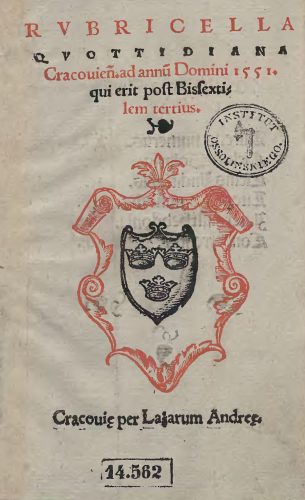
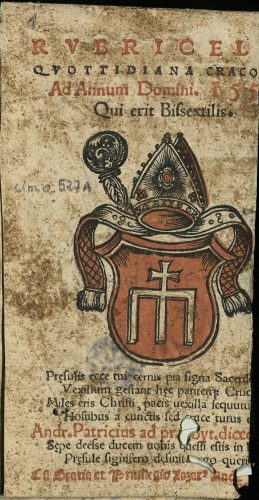
Andrysowic used red to print the cartouche of the Radwan coat of arms of Andrzej Zebrzydowski (bishop of Cracow in 1551–1560), which was in accord with the heraldic colours of the Radwan. The inside parts of two lapets and the mitre along with jewels embellishing it were also printed in red. This created very decorative effects, characteristic also for Andrysowic’s later colour prints.
The elegant, clear and coherent heraldic composition was replaced by an even more decorative image in the following year. In 1552 Andrysowic placed Zebrzydowski’s coat of arms within a wreath held by two putti, modifying Vietor’s earlier woodblock (fig. 3).
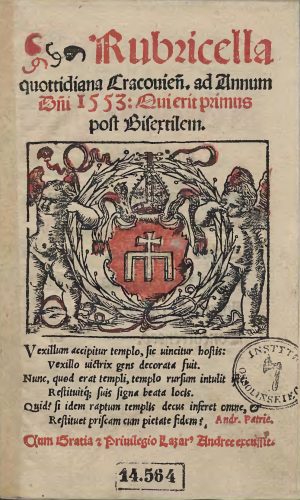
In 1559 he changed the composition again and arrived at a very elegant and medal-like image that might have pleased humanistic-minded viewers (fig. 4). Red complied with the heraldic colours of the coat of arms and, apart from the cartouche, was moderately and accurately used to colour the ribbons and flowers on the wreath.
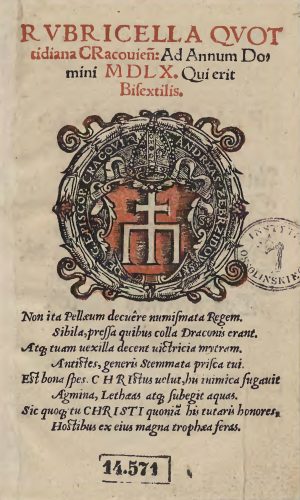

It was not easy for other Cracow printers to emulate the use of the red-and-black coat of arms introduced by Andrysowic. Matthaeus Siebeneicher, who took over the printing of Cracow liturgical calendars in 1570, initially attempted to print Filip Padniewski’s coat of arms in red (fig. 6), even though this has no basis in the heraldic tradition. He started the same way Andrysowic did in 1550, namely avoided overlap of colours and printed the coat of arms and the wreath from two separate woodblocks. Yet, already in the second edition of his Cracow rubricella he gave up on the idea and limited himself to a black-and-white heraldic composition (fig. 7).
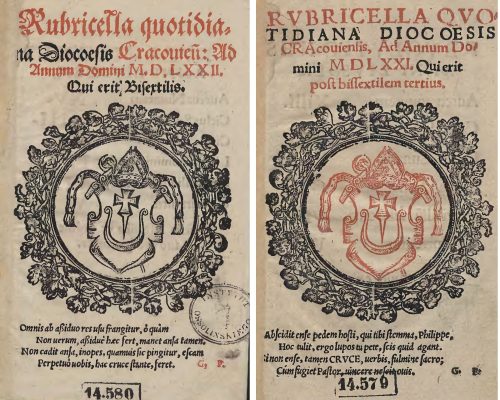
Quoted literature:
Juda, Maria, 1992. Przywileje drukarskie w Polsce [The privileges of printers in Poland], Lublin: Agencja Wydawniczo-Handlowa AD.